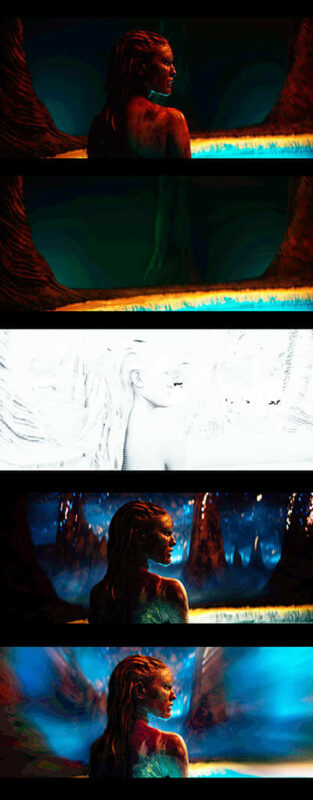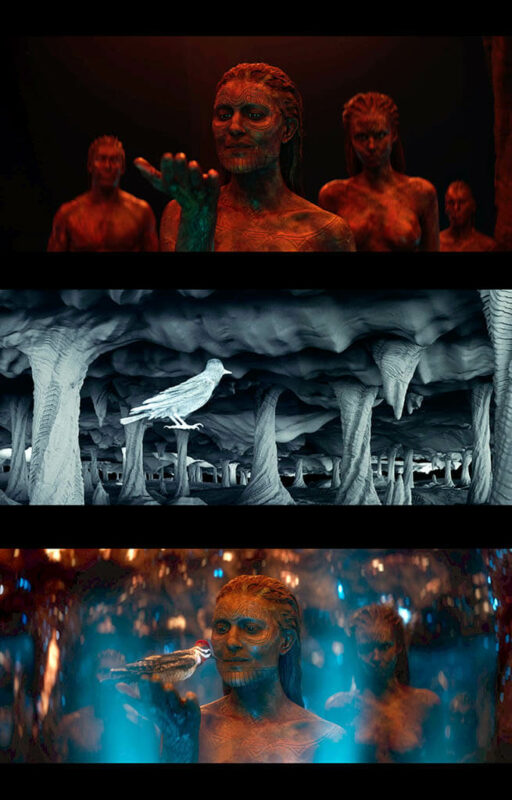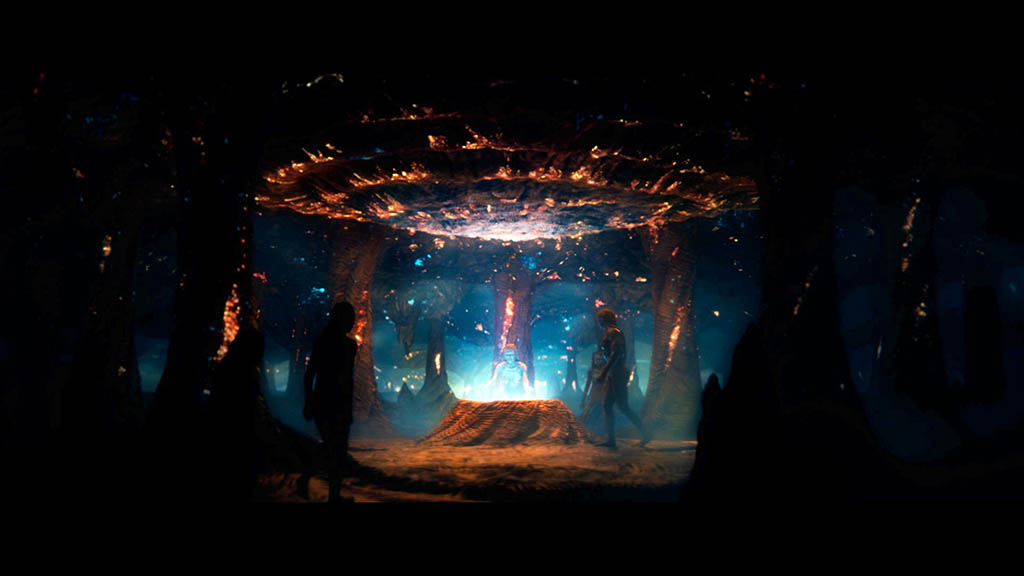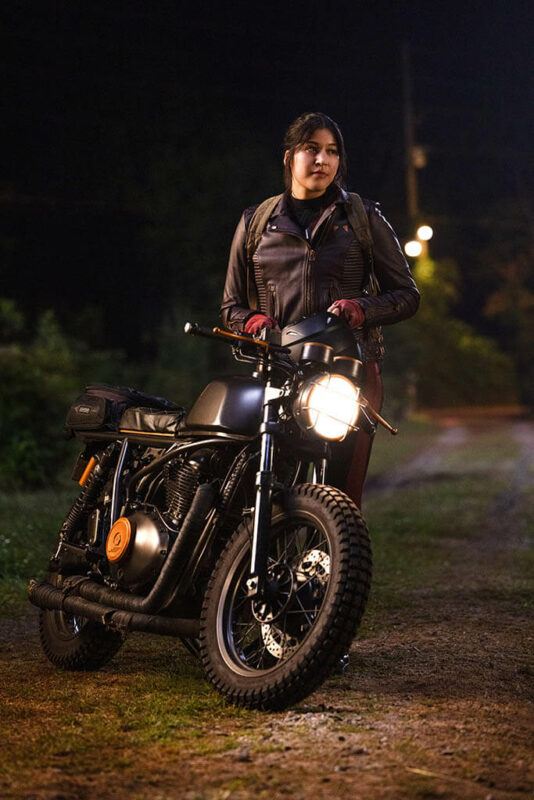By OLIVER WEBB
Images courtesy of Marvel Studios.
By OLIVER WEBB
Images courtesy of Marvel Studios.

Production built a relatively small set featuring the Creation Pools and a circle of columns encircling them.

The Pool of Life sequence is rooted in Choctaw lore where the act of drawing water from the Pool of Life starts a transformation within their world and themselves, eventually turning them into humans.
Set five years after the events of the 2021 Disney+ mini-series Hawkeye, the origin story of Echo follows Maya Lopez as she returns to her hometown in Oklahoma where she is confronted with her troubled past. To move forward with her life, she must reconnect with her Native American roots and embrace the meaning of family and community. Alaqua Cox reprises her Hawkeye role as Maya Lopez/Echo for the sequel.
“In terms of the cave’s look and feel, we had initial concepts from our first designs, but we weren’t sure about our final approach, nor the extent of the virtual set we were going to have to build. My priority, working with CG Supervisor David Liu, was to make sure that our environment felt as real as possible, within reason. Creating this mythical cave was tricky, since we were aiming for realism without good real-world references. This balancing act is always a challenge, so we began experimenting.”
—Aladino Debert, Visual Effects Supervisor, Digital Domain
Aladino Debert served as Digital Domain Visual Effects Supervisor on the show, which streams on Disney+ and Hulu. “The show essentially had two incarnations,” Debert explains. “We originally started in the summer of 2022 doing concept designs and some R&D for the main sequences assigned to us at the time; things like building assets for the ‘Creation Cave’ and digi-doubles for the main Choctaw characters. Then, suddenly, the show was put on hold by the studio and production was stopped. We feared the show was gone for good.” Debert continues, “But six months later, around April 2023, after I’d finished work on Citadel for Amazon, production restarted with a different client-side VFX supervisor and producer team. Having previously worked on Ms. Marvel, I was familiar to the studio, and given my previous, albeit brief, experience with part one of the show, I started work once again.”

There were around a dozen ancestors adorned with clay makeup and wearing underwear that needed to be removed by the roto/paint team, led by Cynthia Trevino.

The close-up shot of Chafa’s hands turned out to be the most stress-inducing shot in the entire show for Debert and his team. They studied time-lapses of dried mud to understand the process.
Debert knew that Digital Domain were mostly going to be involved with the main creation sequence for Episode 01. “Those sequences had been shot already, so we had plates, if not necessarily a locked cut.” Debert says. “Production built a relatively small set featuring the Creation Pools and a circle of columns encircling them. The legend revolves around the ancestors, moulded from clay, emerging from the pools and gathering around Chafa, the first to appear. The sequence is rooted in Choctaw lore, where the act of drawing water from the Pools of Life starts a transformation within their world and themselves, eventually turning them into humans. That, in a nutshell, is the essence of the story.”
“In terms of the cave’s look and feel, we had initial concepts from our first designs, but we weren’t sure about our final approach, nor the extent of the virtual set we were going to have to build,” he continues. “My priority, working with CG Supervisor David Liu, was to make sure that our environment felt as real as possible, within reason. Creating this mythical cave was tricky, since we were aiming for realism without good real-world references. This balancing act is always a challenge, so we began experimenting.”

Visual Effects Supervisor Aladino Debert worked alongside CG Supervisor David Liu to make sure that the environment felt as real as possible, within reason. It was a constant challenge creating a mythical cave while aiming for realism, which resulted in some experimentation.

Debert and his team created around 100 visual effects shots for the show. A cultural consultant from the Choctaw people was on set throughout production due to cultural sensitivities and to ensure missteps were avoided.
Debert and his team looked at lots of caves for reference. “We also looked at glow worms for inspiration since we wanted a bioluminescent, almost nebula-like appearance to the ceiling. It was an evolutionary process as designs often are. That’s why we studied real-life elements found in caves, such as crystal formations, stalactites, stalagmites and so on. For the exterior shots, the story required the clay ancestors to become human, so we knew that the process of the clay drying up, cracking and revealing the human underneath was crucial. We primarily studied time-lapses of dried mud to understand the process. From there, our effects artists, led by FX Supervisor Jaymie Miguel, went to work.”
When it came to managing the workload with his team, Debert approached the project the same way he always does. “To start a project well-prepared, a great producer is essential, and I had the fortune to collaborate with VFX Producer Ryan Wilk on this show. I’m systematic about certain things, and once you’ve been doing this for a while, you realize most projects have similarities,” he remarks.

From left: Vincent D’Onofrio as Wilson Fisk/Kingpin and Darnell Besaw as young Maya Lopez.
“First off, when we receive the turnover of plates, our initial steps involve identifying camera roto/paint needs,” Debert adss. “Camera tracking was straightforward, but, for instance, the women playing the clay ancestors had patches on their nipples, and everyone had underwear on, as one would expect. So, although the makeup team’s work was amazing, there was no way to conceal the fact that you could see what they were wearing. So our roto/paint team, led by Cynthia Trevino, got to work on the task of removing everybody’s underwear. There were maybe 12 or 14 ancestors all adorned with clay makeup and wearing underwear that needed to be removed. We also had to devise a system for color correction that could target specific areas of the clay without appearing too obvious. It was a mix of roto and comp tricks to make sure that we could darken or shift the hue of certain sections. Dealing with a single person who wasn’t moving much would’ve not been a big deal, but once you have 12 or more with motion blur, it became quite the challenge.”

Alaqua Cox reprised her role from Hawkeye as Maya Lopez/Echo. (Photo: Chuck Zlotnick)
“We also looked at glow worms for inspiration since we wanted a bioluminescent, almost nebula-like appearance to the ceiling [of the cave]. It was an evolutionary process as designs often are. That’s why we studied real-life elements found in caves, such as crystal formations, stalactites, stalagmites and so on. For the exterior shots, the story required the clay ancestors to become human, so we knew that the process of the clay drying up, cracking and revealing the human underneath was crucial. We primarily studied time-lapses of dried mud to understand the process. From there, our effects artists, led by FX Supervisor Jaymie Miguel, went to work.”
—Aladino Debert, Visual Effects Supervisor, Digital Domain
Continues Debert, “And, of course, we had to create the cave. The clients asked for a sense of infinity, wanting it to seemingly stretch on forever. Which was all good, but, of course, we had to build it and then collapse it! That was a predictably long process. Environments Lead Chris Watkins and his team began with what was built on set and then expanded upon it. Ultimately, it took on a cathedral-like look, but with an organic and natural feel, featuring stalactites, stalagmites and a lot of that bioluminescent light. Additionally, the columns, ceilings and floor had veins of lava running through them, so cooling lava was another reference we studied. We wanted to recreate the effect of charred, blackened exterior contrasted with undulating veins of red, glowing bits. The digital set went on forever and ended up being a massive environment that was at times quite tricky to render.”

From left: Zahn McClarnon as William Lopez, Devery Jacobs as Bonnie, Graham Greene as Skully and Tantoo Cardinal as Chula Battiest.
Debert and his team created around 100 visual effects shots for the show, most of which were for the Choctaw creation sequence. “In the story, Chafa, the first ancestor, drinks from the Pool of Life, initiating the collapse of their underground world, and setting in motion the process that ultimately leads them to become human. As the cave collapses around them, she holds up the ceiling to allow her people to escape. The realism of this sequence was crucial, and I wanted to make sure it felt natural in the way that it was breaking up. The cave couldn’t just collapse into dust. As always, I started by looking at a lot of references of post-earthquake imagery to understand how columns shear and partially collapse without disintegrating entirely. That approach is one that resonates with my work ethos: start with realism as a baseline and then adjust to suit the desired aesthetic or narrative tone. It gives us a solid ground to stand on, no pun intended in this case, while at the same time allows the freedom to deviate artistically when needed.”

Set five years after the events of Hawkeye, the origin story of Echo follows Maya Lopez as she returns to her hometown where she is confronted with her troubled past.
Initially Debert’s plan involved simulating the collapse in a linear fashion, starting a distance away from the Pool of Life and ending at its center where the ancestors were. “The idea was to position cameras strategically and allow the dynamics of the scene to dictate the performance,” Debert explains. “But the edit changed throughout the project, and that plan had to be modified since the jumps in the timeline introduced inconsistencies. Thankfully, we had created custom simulations of ceiling collapses or columns crumbling that would be placed tactically to smooth out any continuity issues.”
“The realism of this sequence was crucial, and I wanted to make sure it felt natural in the way that it was breaking up. The cave couldn’t just collapse into dust. As always, I started by looking at a lot of references of post-earthquake imagery to understand how columns shear and partially collapse without disintegrating entirely. That approach is one that resonates with my work ethos: start with realism as a baseline and then adjust to suit the desired aesthetic or narrative tone. It gives us a solid ground to stand on, no pun intended in this case, while at the same time allows the freedom to deviate artistically when needed.”
—Aladino Debert, Visual Effects Supervisor, Digital Domain

Chaske Spencer as Henry Black Crow Lopez. (Photo: Chuck Zlotnick)

Stunt coordinator Mark Scizak was able to incorporate Cox’s prosthetic leg into her fights. (Photo: Chuck Zlotnick)
“A good illustration of the balance between reality and art involved dust. Initially, our shots featured a significant amount of it, limiting visibility into the distance – something that, to me, felt realistic given the context of collapsing rock. However, the client emphasized the need to see more of the cave collapsing, a crucial part of the story, which in retrospect seemed obvious. So, we ended up pulling back a lot of the atmospherics and finding a good balance between realism and creative choices. Compositing Supervisor Eric Beaver and his team were essential in finding that balance.”

Debert followed up working on Ms. Marvel, where the lead character is a Pakistani American teenager, with Echo, where the main character is a deaf Native American woman – two female heroes in the male-dominated superhero world. (Photo: Chuck Zlotnick)
“[T]hree weeks from delivery, we realized we were in trouble: We didn’t have a clean plate of hands for the entirety of this shot, necessitating the creation of full CG hands. Trouble was, we didn’t have accurately modeled CG hands because we hadn’t anticipated needing them! It’s one of those realizations that only hit you in hindsight. … That particular shot turned out to be the most stress-inducing shot in the entire show, catching us completely off guard. It was our infamous ‘pineapple shot.’ Go ahead and Google that! ”
—Aladino Debert, Visual Effects Supervisor, Digital Domain

Vincent D’Onofrio as Wilson Fisk/Kingpin and Alaqua Cox as Maya Lopez/Echo.
Debert and his team also worked on the Biskinik bird, sacred to the Choctaw people and featured on several shots during the creation sequence (the bird was an asset shared with ILM, which was also working on the show). As complex as the bird shots were however, for Debert the most challenging visual effects shot to create involved Chafa’s hands becoming human. “Our R&D for the clay-to-human simulation primarily had focused on larger sections of the body, such as the head and torso, and we were pretty happy with the results,” Debert notes. “The edit had two shots of Chafa observing her hands as the clay cracks and crumbles, revealing her human hands beneath. In the original cut the first shot mostly featured clay hands, followed by an insert of her observing the crumbling, before cutting to the final shot where most of the clay was gone, revealing the actual plate photography of her hands.”

Alaqua Cox as Maya Lopez and Vincent D’Onofrio as Wilson Fisk/Kingpin.
Continues Debert: “We started working on those shots by making sure we had accurate match-moving and determining the balance between CG hands, clay and plate. It was essential for the hands to appear natural, as inside the cave they were only decorated with makeup, resembling normal hands albeit made of clay. So, we aimed for a thin, almost potato-skin-like appearance to avoid a chunky look, which would not be attractive for close-up hands. But then the editor decided to merge those two shots into one that spanned the entire clay-to-human transition, one that would end up being a long close-up shot of hands. Initially, we thought we would simply use a long simulation of the clay crumbling over the combined plate since the original shots were derived from the same plate with an offset. We assumed it would be straightforward and continued working on the simulation side until, three weeks from delivery, we realized we were in trouble: We didn’t have a clean plate of hands for the entirety of this shot, necessitating the creation of full CG hands. Trouble was, we didn’t have accurately modeled CG hands because we hadn’t anticipated needing them!”

One of the first things Debert did when he joined Echo was forge a collaborative relationship with the show’s well-prepared VFX Producer, Ryan Wilk.
“It’s one of those realizations that only hit you in hindsight,” Debert acknowledges. “None of us considered the potential problems until we were dangerously close to delivery. That particular shot turned out to be the most stress-inducing shot in the entire show, catching us completely off guard. It was our infamous ‘pineapple shot.’ Go ahead and Google that! However, the entire team pulled together and came up with very creative solutions to the problems we were facing, and in the end the client was very happy with the result.”
A cultural consultant from the Choctaw people was on set throughout production due to the cultural sensitivities involved. “We had to make sure that the basic designs of the Pool of Life, for instance, or the Birth Mound where the ancestors emerge from after the cave collapses, met with approval from the consultants, so we would present to them for feedback. There were only a couple of times where changes or tweaks were needed, and they were minor, but, nevertheless, it was crucial for us to receive this feedback because it was a sensitive topic, and we wanted to ensure we handled it with care and avoided any missteps.”


Julia Jones as Chafa. The Choctaw legend of the Pools of Life revolves around ancestors, moulded from clay, emerging from the pools and gathering around Chafa, the first to appear, starting the transformation process from clay to human.
Concludes Debert, “When you are working on a show or sequence based on myths or legends, the approach is inherently subjective, and the challenge lies in creating elements that may not exist while ensuring they appear realistic. This requires a fine balance of artistic interpretation and attention to detail. I’ve been fortunate to work on culturally diverse shows lately. In my previous show for Marvel Studios, Ms. Marvel, the lead character, is a Pakistani American teenager with amazing powers. That show was significant to me as it introduced a different family culture, religion and dynamic to the MCU. So, to follow that up with Echo, where the main character, Maya Lopez [played by Alaqua Cox], is a deaf Native American woman with a prosthetic leg and a total badass, was a real joy. It offered a diverse representation within the male-dominated superhero world we’ve grown accustomed to. I learned a lot about Choctaw history from reading and researching for this show, making it rewarding both on a personal level and in terms of the technical challenges, which I always enjoy.”